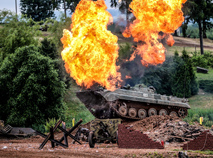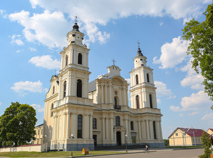Minsk Oblast Landmarks

Minsk Oblast is the biggest province in Belarus, the only one that borders on no neighboring countries, a region with a great industrial and scientific potential yet featuring a trove of interesting ancient history. The most prominent places of interest in Minsk Oblast include the internationally recognized Nesvizh Palace of the Radziwills family, a Catholic church of the Bernardians in Budslav, the ancient towns of Zaslavl, Borisov, Slutsk, Molodechno, Myadel, the national park Narochansky. At the crossroads of European ways Minsk Oblast has seen major wars and tragic events of the world. Tourists can now remember those events in the Brilyovskoye field near the Berezina River, Khatyn, Trostenets, the Glory Mound, Stalin’s Line… Minsk Oblast is home to the country’s top alpine skiing resorts and Olympic sport training facilities.
Khatyn Memorial

The Khatyn Memorial is a symbol of tragedy and unbelievable courage of the Belarusian people; it is a tribute to the memory of every third Belarusian killed in the Great Patriotic War… The Belarusian village of Khatyn is famous all over the world. Here on 22 March 1943 the Nazi brutally murdered 149 local residents, including the elderly and 75 children. The people were burnt alive in a locked barn. Those who tried to escape from the fire were shot dead. This impressive memorial was built in place of the village to commemorate the tragedy of Khatyn and hundreds of other villages destroyed together with its residents. More than 36 million people from around the world visited the place since the memorial was unveiled in 1969.
![]() Logoisk District. There is a guide sign “Khatyn” 54 kilometers away from Minsk on the M3 Minsk-Vitebsk highway. The Khatyn Memorial will be just 5 kilometers away.
Logoisk District. There is a guide sign “Khatyn” 54 kilometers away from Minsk on the M3 Minsk-Vitebsk highway. The Khatyn Memorial will be just 5 kilometers away.
![]() 10.30 – 15.00, closed on Monday
10.30 – 15.00, closed on Monday
![]() There is also a memorial complex Dalva located not far from Khatyn. This memorial stands on the place of the village that shared the fate of Khatyn. On 19 June 1944 the Nazi burnt alive 29 local children, 13 women and 2 men.
There is also a memorial complex Dalva located not far from Khatyn. This memorial stands on the place of the village that shared the fate of Khatyn. On 19 June 1944 the Nazi burnt alive 29 local children, 13 women and 2 men.
Mound of Glory Memorial Complex

The Mound of Glory commemorates Belarus’ liberation from the Nazi invaders. Taking part in Operation Bagration, a codename for the Soviet 1944 Belorussian Strategic Offensive Operation and one of the biggest operations in the history of humankind, were four fronts led by outstanding military leaders Rokossovsky, Zakharov, Chernyakhovsky and Bagramyan, as well as sailors of the Dnieper river flotilla, French pilots from the Normandie-Niemen Regiment and, of course, Belarusian partisans. The Mound of Glory Memorial Complex is 70.6m high. On top of the hill (35m) that holds the soil brought from the hero cities are four bayonets symbolizing the brotherhood of fatherland defenders, and a glory ring depicting the faces of soldiers and partisans.
![]() Two concrete stairways lead to the Mound of Glory, 241 steps each. At the bottom is an open-air museum where one can see legendary weapons and tanks of the Great Patriotic War.
Two concrete stairways lead to the Mound of Glory, 241 steps each. At the bottom is an open-air museum where one can see legendary weapons and tanks of the Great Patriotic War.
![]() Smolevichi District, 21 kilometers from Minsk on the M1 Minsk-Moscow highway
Smolevichi District, 21 kilometers from Minsk on the M1 Minsk-Moscow highway
Stalin’s Line History and Heritage Museum

The fascinating open-air military museum is located in the Minsk fortified zone, which was part of the famous Stalin’s Line built in 1930 along the borders of the USSR stretching from Karelia in the north to the Black Sea coast in the south. The museum has authentic pillboxes from the times of the war. It also features all kinds of trenches and antitank ditches, shooting positions, bunkers for soldiers and trenches for guns. The museum has Belarus’ biggest exposition of military equipment, aviation and weapons of different years, starting from the times of the Great Patriotic War, a unique collection of gun turrets from the First World War...
Stalin’s Line is an interactive museum: Here you can see the reenactment of historical battles, fire a real weapon from the times of the Great Patriotic War (Mauser, Mosin rifle or Maksim machine-gun), drive a modern armored vehicle and legendary tanks, and taste soldier's porridge. The museum has the memorial "Maritime Glory of Belarus" that boasts a 300-year-old anchor of the times of Peter the Great and famous amphibious tank PT-76.
![]() 10.00-18.00, closed on Monday
10.00-18.00, closed on Monday![]() Minsk District, near the village of Loshany, 6km away from the town of Zaslavl
Minsk District, near the village of Loshany, 6km away from the town of Zaslavl
Zaslavl History and Heritage Museum-Reserve
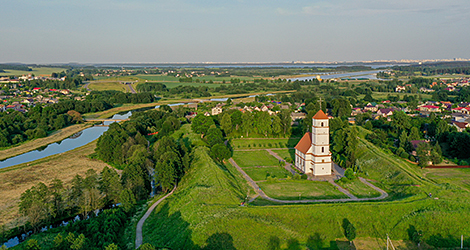
Zaslavl, one of the most ancient towns of Belarus, will turn 1,040 years in 2025. Its history is connected with the tragic fate of the Polotsk Princess whose family was destroyed by the husband, Kiev Prince Vladimir. After the failed attempt to avenge, Rogneda, who became the first Belarusian Christian, returned to the homeland. A new town was built for her and her son Izyaslav who was called prince the bookman for his wisdom… Today, the museum-reserve brings together more than a hundred hectares of the ancient part of Zaslavl, specimens of history and architecture: the ancient settlement Zamechak (10th-11th centuries), burial mounds of the 10th -11th centuries, ancient settlement Val, Holy Transfiguration Church (formerly a Calvinist church), a Roman-Catholic church of the 18th century, a palace and park ensemble...
![]() The museum-reserve also includes a museum exposition, the ethnographic complex Mlyn (Mill), a museum-pillbox and a children's museum of myths and forests.
The museum-reserve also includes a museum exposition, the ethnographic complex Mlyn (Mill), a museum-pillbox and a children's museum of myths and forests.
![]() 9.00-17.00, closed on Monday
9.00-17.00, closed on Monday
![]() 4 Rynochnaya Street, the town of Zaslavl (museum and exhibition complex)
4 Rynochnaya Street, the town of Zaslavl (museum and exhibition complex)
Brili Field History and Heritage Memorial
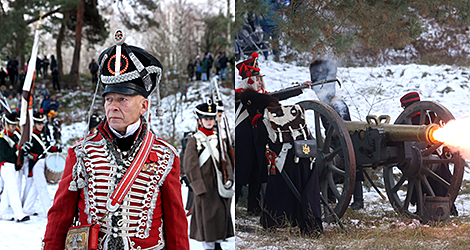
One of the largest battles of the 1812 war took place in the vicinity of the town of Borisov in November 1812: retreating Napoleon's forces were defeated, and the Berezina River became a synonym of disaster in the French language. On its banks, near the Belarusian village Studenka and Brili, 50,000 soldiers were killed: the French, Russians, Belarusians, Poles and Germans. Today the Brili Field complex dedicated to the Berezina crossing combines the monuments and burial places, a symbolic grove and burial mounds. This is the place for grandiose battle reenactments bringing together reenactment clubs from Belarus, Russia, Poland, France, and Switzerland...
![]() Memorials in memory of the Berezina crossing were installed in the village of Studenka and near the Borisov-Zembin highway. A fragment of the wing of the manor – Napoleon’s House (where the French Emperor stayed) has survived in the village of Staroborisov.
Memorials in memory of the Berezina crossing were installed in the village of Studenka and near the Borisov-Zembin highway. A fragment of the wing of the manor – Napoleon’s House (where the French Emperor stayed) has survived in the village of Staroborisov.
![]() Village of Brili, Borisov District
Village of Brili, Borisov District
Narochansky National Park
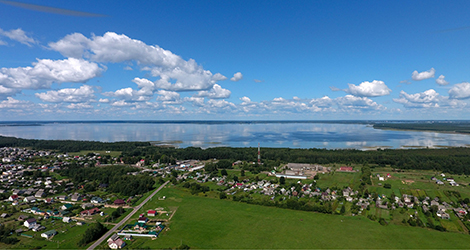
Belarus’ biggest lake Naroch as well as a score of other glacial lakes of striking beauty are the pearls of Narochansky National Park. Among those is 40-meter deep Bolduk, transparent Glublya, heart-shaped Glubelka, mysterious Dead Lake, which feeds from swamp waters… The flora of the place stuns as dozens of rare plants can be found on relatively small territories, which proves the cleanness of the ecosystem. No wonder that the Naroch Krai has turned into Belarus’ biggest health resort, famous for its healing water and mud springs and a pleasant moderate climate.
![]() Visitors to Narochansky National Park can go on a boat trip or take walk along an eco-path, go diving, take a ride on a helicopter or explore the resort during an audio tour.
Visitors to Narochansky National Park can go on a boat trip or take walk along an eco-path, go diving, take a ride on a helicopter or explore the resort during an audio tour.
![]() Myadel District, Naroch health resort
Myadel District, Naroch health resort
Church in Budslav, National Sanctuary of the Budslav Icon of the Mother of God

The grand church of the Ascension of the Blessed Virgin Mary in the village of Budslav, Belarus’ biggest Catholic church, enraptures with its architecture and remarkable history. A wooden temple was founded by Bernardine monks in the 16th century. One of the most worshipped Catholic relics of Belarus, Wonderworking Icon of the Mother of God, has been kept in Budslav since 1613. The icon was given by Pope Clement VIII to Minsk war chief Yan Pats in 1598. Besides, there is a unique wooden altar in St. Barbara Chapel built in 1643.
![]() In recognition of a special role of the Budslav church in the life of Belarusian Catholics, Pope John Paul II gave the church the title of a minor basilica in 1994. It is one of Belarus’ most prominent meeting places for pilgrims from around the world.
In recognition of a special role of the Budslav church in the life of Belarusian Catholics, Pope John Paul II gave the church the title of a minor basilica in 1994. It is one of Belarus’ most prominent meeting places for pilgrims from around the world.
![]() Myadel District, the village of Budslav
Myadel District, the village of Budslav
Belarusian State Vernacular Architecture and Ethnic Heritage Museum in Ozertso
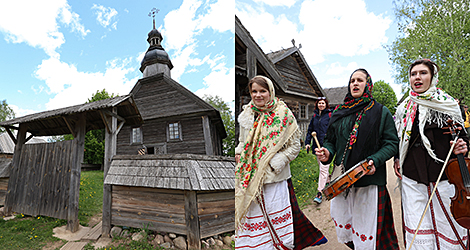
The original open-air museum village which features architectural monuments of the 17th-20th centuries is located several kilometers away from Minsk. Ancient wooden houses of peasants, a windmill and a barn, an 18th century church and a Sunday school, a blacksmith’s shop and a tavern were brought here from various parts of the country. They represent three ethnographic regions - Central Belarus, Poozerye and Dnieper Region. The open-air museum hosts numerous folk holidays and original festivals, such as Kolyady, the Kupala Night festival, the project Masterpieces of World Classics in the Open-Air Museum, the cheese festival, the Kamyanitsa folk festival, all the year round…
![]() In winter from 10.00 to 15.00, in summer from 10.00 to 17.30; closed on Monday and Tuesday
In winter from 10.00 to 15.00, in summer from 10.00 to 17.30; closed on Monday and Tuesday
![]() Minsk District, the village of Ozertso
Minsk District, the village of Ozertso
Priluki Castle

The legend has it that the mysterious castle in the village of Priluki was built in place of an Orthodox monastery that was ruined in 1740 for an unknown reason. The manor belonged to the representatives of affluent families, such as Oginskis, Ivanovskys, Gorvatts, Wisniowieckis. In 1871, the estate seriously damaged by the fire was bought by famous Count Emeryk Hutten-Czapski, an influential minister of Emperor Alexander II, an ardent collector of coins and medals and a great art amateur. He turned this wonderful Neo-Gothic castle into the home of muses for composers, musicians, artists…
![]() In accordance with the Czapskis’ project, guests of the manor covered the distance between the original entry to the main building in 365 steps, the number equal to the number of days in the year. At present the palace houses a research institute.
In accordance with the Czapskis’ project, guests of the manor covered the distance between the original entry to the main building in 365 steps, the number equal to the number of days in the year. At present the palace houses a research institute.
![]() Minsk District, the agrotown of Priluki
Minsk District, the agrotown of Priluki
Palace and Park Ensemble in Stankovo village/Homestead of the Hutten-Czapski family in Stankovo village
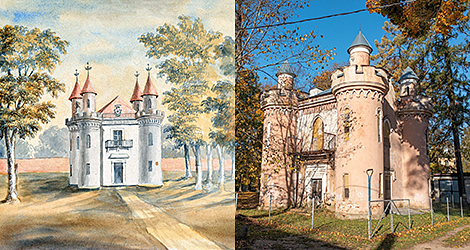
In the village of Stankovo Count Emeryk Hutten-Czapski built a wonderful manor that became his family nest. The palace itself reflected his nostalgia for the Middle Ages. It was burnt down during the Second World War, but other buildings remained untouched. For example, the count’s major pride – Skarbnitsa (treasury) – a two-storey pavilion with corner towers and gothic roofs some time ago housed a unique numismatic collection, a library featuring thousands of rare books and old maps, fine art paintings and ancient porcelain, the rarities found during the diggings at the Stankovo burial mounds, etc.
![]() The manor has preserved its old entrance gate, the blacksmith's shop, a servants’ house, a kitchen outbuilding with an underground passage, a water tower, a barn, a family vault, and a summer house with a view to St. Nicholas Church built in the 19th century that is currently under reconstruction.
The manor has preserved its old entrance gate, the blacksmith's shop, a servants’ house, a kitchen outbuilding with an underground passage, a water tower, a barn, a family vault, and a summer house with a view to St. Nicholas Church built in the 19th century that is currently under reconstruction.
![]() Dzerzhinsk District, Stankovo village
Dzerzhinsk District, Stankovo village
Dzerzhinovo Homestead Museum

The isolated farmstead of Dzerzhinovo is the birthplace of a legendary person of the 20th century. One of the most prominent Soviet revolutionaries, statesman and party activist, founder of the Soviet security services Felix Dzerzhinsky acquired the nickname “Iron Felix”. The original family homestead was burnt down by the Nazi in 1943, but later it was reconstructed. The museum recreates the interior decoration of the rooms and houses the items that belonged to the Dzerzhinsky family in the late 19th – early 20th centuries, including pieces of furniture, personal belongings, books, and unique family photographs…
![]() Until the year of 2004 the memorial complex featured 48 boulders, equal to the number of years of Felix Dzerzhinsky’s life. Today the stones are placed along the avenues leading to the museum.
Until the year of 2004 the memorial complex featured 48 boulders, equal to the number of years of Felix Dzerzhinsky’s life. Today the stones are placed along the avenues leading to the museum.
![]() 9.00 – 17.00. Closed on Sunday and Monday
9.00 – 17.00. Closed on Sunday and Monday
![]()
Stolbtsy District, Petrilovichi village
Museum of Ancient Folk Crafts and Technologies Dudutki

One of the most popular ethnographic museums of Belarus is located near the village of Dudichi, which was owned for 130 years by the famous family of the Yelskies. In the late 1990s a unique complex was created to tell visitors about the everyday life of a Belarusian countryside house of the 19th century. Dudutki offers an ethnographic gallery and a large yard full of craft shops, a wooden church, a windmill and a bakery, a brewery and a creamery… There you will be able to get familiar with secrets of ancient crafts, feel the charm of folk rites and celebrations, taste the genuine freshly baked Belarusian bread…
![]() A garage full of retro cars is another point of interest in Dudutki. There you will see such brands as ZIM, Chaika, Horch, Willys, Volkswagen Beetle, Hanomag, Fiat Topolino, and Chrysler…
A garage full of retro cars is another point of interest in Dudutki. There you will see such brands as ZIM, Chaika, Horch, Willys, Volkswagen Beetle, Hanomag, Fiat Topolino, and Chrysler…
![]() 10.00-17.00 on Tuesday-Wednesday, 10.00-18.00 on Thursday-Sunday, closed on Monday
10.00-17.00 on Tuesday-Wednesday, 10.00-18.00 on Thursday-Sunday, closed on Monday
![]() The village of Ptich, Pukhovichi District
The village of Ptich, Pukhovichi District
Dukora Estate (Dukorsky Mayontak)

Now the historical and tourist center, Dukorskі Mayontak was a gentry estate. In different times it was owned by the well-known families of the Kezgaylos, Sapiehas, Zawiszas, Oginskis, Oshtorps, Gartings. Today the center revives the old traditions of the Belarusian nobility. It offers historical horse riding and fencing classes, dancing and live music, forgotten outdoor entertainment and original fests, restored dishes of the noble cuisine and traditional drinks… Thus, the ivisots of the center can get the feel of what life was like a few centuries back.
![]() Covering 25 hectares, Dukora Estate includes a museum, the old park with a water system, craft shops, a winery, taverns, the gate and the tower that survived since the end of the 18th century, a carriage workshop dating back to the same period, a zoo and a 400-year-old oak of wishes (locals believe that your wish will come true if you touch the tree), guest houses, rope hurdles and an usual Upside Down House.
Covering 25 hectares, Dukora Estate includes a museum, the old park with a water system, craft shops, a winery, taverns, the gate and the tower that survived since the end of the 18th century, a carriage workshop dating back to the same period, a zoo and a 400-year-old oak of wishes (locals believe that your wish will come true if you touch the tree), guest houses, rope hurdles and an usual Upside Down House.
![]() 10:00-18:00 (entry till 17:00), closed on Monday
10:00-18:00 (entry till 17:00), closed on Monday
![]() 15 Shkolnaya Street, Dukora, Pukhovichi District
15 Shkolnaya Street, Dukora, Pukhovichi District
Chaim Soutine Museum in Smilovichi
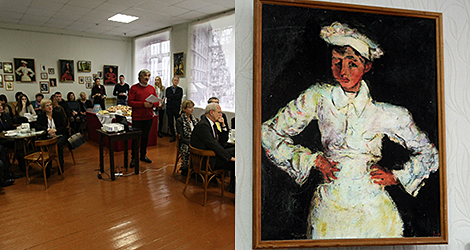
Chaim Soutine, one of the outstanding representatives of the Paris School, a friend of Amedeo Modigliani and Marc Chagall, was born in the Belarusian town of Smilovichi in 1893. After the emigration he found a shelter in the famous La Rouche in Paris. He spent many years in the south of France where he tried to win over the Paris public, and made his talented paintings. Once, American collector Albert Barns bought about 60 paintings by Chaim Soutine. The Space of Chaim Soutine Museum was opened in his hometown in 2008. The exposition titled as Home: Smilovichi-Minsk-Vilno tells about the family of the artist, his life in the town, his studies in Minsk and Vilno. The second hall styled like a Paris cafe tells about the legacy of the author and his friends – natives of Lithuania and Belarus, displays the reproductions of the works by Marc Chagall, Ossip Zadkine, Michel Kikoine, Pinchus Kremegne, Oscar Meschaninov and Amedeo Modigliani are presented there.
![]() 20 Revolutsionnaya Street, Smilovichi, Minsk Oblast
20 Revolutsionnaya Street, Smilovichi, Minsk Oblast
![]() 9.00-17.00; 9.00-14.00 on Saturday closed on Monday
9.00-17.00; 9.00-14.00 on Saturday closed on Monday
The National Historical and Cultural Museum Nesvizh

The ancient town located one hundred kilometers away from Minsk is well-known far beyond Belarus. It is home to the beautiful palace and park complex placed on the UNESCO World Heritage List, the residence of the once powerful dynasty of the Radziwills. There are also other unique historical and architectural monuments in the town. The Nesvizh Catholic Church of God’s Body is Eastern Europe’s first Baroque style temple where the family crypt of the Radziwills is located (in terms of numbers it is Europe’s third after the crypts of the Habsburgers and the Bourbons). The Nesvizh Town Hall is the oldest one in Belarus. It was built in 1596. The Slutsk Castle Gate is the only gate still standing that used to be part of the town defenses.
![]() The compound of the former convent of the Benedictines in Nesvizh is Belarus’ first convent built in 1593-1596. A college now occupies the buildings that have survived the test of time.
The compound of the former convent of the Benedictines in Nesvizh is Belarus’ first convent built in 1593-1596. A college now occupies the buildings that have survived the test of time.
![]() Nesvizh
Nesvizh







 print version
print version make home page
make home page add to bookmarks
add to bookmarks





